|
|
|
Sort Order |
|
|
|
Items / Page
|
|
|
|
|
|
|
| Srl | Item |
| 1 |
ID:
178578


|
|
|
|
|
| Summary/Abstract |
Whereas scholars have typically modeled climate change as a global collective action challenge, we offer a dynamic theory of climate politics based on the present and future revaluation of assets. Climate politics can be understood as a contest between owners of assets that accelerate climate change, such as fossil fuel plants, and owners of assets vulnerable to climate change, such as coastal property. To date, obstruction by “climate-forcing” asset holders has been a large barrier to effective climate policy. But as climate change and decarbonization policies proceed, holders of both climate-forcing and “climate-vulnerable” assets stand to lose some or even all of their assets' value over time, and with them, the basis of their political power. This dynamic contest between opposing interests is likely to intensify in many sites of political contestation, from the subnational to transnational levels. As it does so, climate politics will become increasingly existential, potentially reshaping political alignments within and across countries. Such shifts may further undermine the Liberal International Order (LIO); as countries develop pro-climate policies at different speeds and magnitudes, they will have incentives to diverge from existing arrangements over trade and economic integration.
|
|
|
|
|
|
|
|
|
|
|
|
|
|
|
|
| 2 |
ID:
177151
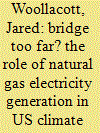

|
|
|
|
|
| Summary/Abstract |
Natural gas has been promoted as a ‘‘bridge’’ fuel toward a low-carbon future by offering near-term emissions reductions at lower cost. Existing literature is inconclusive on the short-term emissions benefits of more abundant natural gas. The long-lived nature of natural gas infrastructure also threatens to lock in emissions levels well above longer-term targets. If natural gas can offer short-to-medium term benefits, how much of a bridge should we build? Using ARTIMAS, a foresighted computable general equilibrium model of the US economy, we interact scenarios developed by the EMF-34 study group related to abundant natural gas, low-cost renewables, and a carbon tax to examine the role of natural gas in a carbon-constrained future. We find that abundant natural gas alone does not have a significant impact on CO2 emissions. We also find that, under a higher carbon tax, natural gas investment of approximately $10 billion per year declines to zero at a tax of about $40/ton and existing natural gas assets face significant risk of impairment. Last, the presence of abundant natural gas lowers the marginal welfare cost of abating small amounts of CO2 but is likely to raise the cost of abatement levels consistent with common climate objectives. The integrated welfare costs of climate policy depend on how much abatement we must undertake.
|
|
|
|
|
|
|
|
|
|
|
|
|
|
|
|
| 3 |
ID:
181527
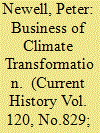

|
|
|
|
|
| Summary/Abstract |
Without deep transformations in the economy that go beyond incremental gains in decarbonization, we remain on course for catastrophic global heating. Some businesses have pledged to go carbon-neutral, carbon-trading schemes are expanding, and a growing divestment movement has pressured investment funds to shun fossil fuel producers. But financial forces are also part of the problem, still driving more production and consumption of fossil fuels. Achieving transformational shifts in finance, production, and governance calls for a more disruptive politics underpinned by shifts in power relations.
|
|
|
|
|
|
|
|
|
|
|
|
|
|
|
|
| 4 |
ID:
169859
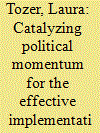

|
|
|
|
|
| Summary/Abstract |
This paper expands the toolkit available to consider the effectiveness of urban climate responses by examining political effectiveness in the implementation of urban decarbonization initiatives. By focusing on the politics of implementation, this approach complements dominant approaches for assessing effectiveness that emphasize greenhouse gas emission accounting. Drawing on case studies of urban building low carbon governance in Stockholm, London and San Francisco incorporating 40 expert interviews, the analysis provides insight into whether climate change mitigation measures are catalyzing political momentum that is untangling fossil fuels from institutions. It finds that urban decarbonization is gaining political momentum when it comes to new buildings, although with concerning implications for inequality and uneven development, but systemic change is limited since efforts to target existing buildings are stumbling over challenges. Two key insights are highlighted: 1) reframing the policy goal of urban climate mitigation to decarbonization productively refocuses attention on systemic change; 2) effective urban carbon governance is not only about providing instrumental tools, but it also involves triggering political dynamics that build momentum. Future urban decarbonization initiatives should consider the complementary roles of offering instrumental solutions and catalyzing political momentum through implementation.
|
|
|
|
|
|
|
|
|
|
|
|
|
|
|
|
| 5 |
ID:
179719


|
|
|
|
|
| Summary/Abstract |
This paper explores the differences in technological priorities for decarbonization of the Russian and the European power sectors up to 2040 and investigates the main drivers of such differences. We used updated cost and performance data to conduct a comparative analysis of technologies based on levelized cost of electricity. Calculation of carbon avoided costs allowed us to found the pool of cost-efficient low-carbon technologies for the Russian power industry as well as the level of carbon prices needed to support their development. Also, we have explained the reasons which cause differences in decarbonization priorities in Russia and Europe. We have also investigated the impact of system requirements (and associated costs) in terms of capacity availability and its operating modes on the competitiveness of renewable energy sources and conventional power plants. Consideration of these requirements and costs improves the quality of power system planning and policy-making processes under the strict limits on greenhouse gas emissions. Based on performed analysis we suggest economically reasonable decarbonization strategy of the Russian power industry as well as the necessary level of carbon prices/taxes for various low- and non-carbon technologies to support their development.
|
|
|
|
|
|
|
|
|
|
|
|
|
|
|
|
| 6 |
ID:
168642
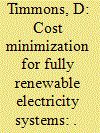

|
|
|
|
|
| Summary/Abstract |
Climate change is the world's most prominent environmental problem, and fossil-fuel combustion is its primary cause. To set carbon reduction goals, policy makers require information on feasibility and cost of renewable energy systems. In this study, we describe an economic approach to modeling a national electricity system based entirely on renewable sources, using the island-nation of Mauritius as a case study.
|
|
|
|
|
|
|
|
|
|
|
|
|
|
|
|
| 7 |
ID:
171427


|
|
|
|
|
| Summary/Abstract |
Mitigation strategies towards progressive decarbonization of the energy system are a valid approach to slow environmental pollution yielding social benefits, as established from National Energy and Climate Plan (NECP). The first objective is the increase of energy efficiency within 2030 by promoting the use of renewable energy and the electrification of consumption in other sectors (household and transport). Cost-benefit analysis (CBA) is an analytical tool to evaluate investments and support policy decisions for society's welfare. The paper aims to assess how CBA can be used to quantify the costs and related social benefits in different sectors (energy, transport and household) if the decarbonization scenario is applied in Italy in 2030. Overall, our findings show positive benefits obtained with the adoption of different mitigation strategies for all sectors. These results can provide significant support to decision-makers in the implementation of decarbonization scenario in Italy scheduled for 2030.
|
|
|
|
|
|
|
|
|
|
|
|
|
|
|
|
| 8 |
ID:
096633
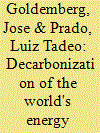

|
|
|
|
|
| Publication |
2010.
|
| Summary/Abstract |
Decarbonizing" the world's energy matrix is the strategy being implemented by most countries to reduce CO2 emissions and thus contribute to achieve the ultimate objectives of the Climate Convention. The evolution of the carbon intensity (Ic=CO2/GDP) in the period 1990-2007 was encouraging but not sufficient to reduce the growth of carbon emission. As a result of COP-15 in Copenhagen these countries (and regions) made pledges that could lead to more reduction: for the United States a 17% reduction in CO2 emissions by 2020 below the level of 2005; for the European Union a 20% reduction in CO2 emissions by 2020 below the 1990 level; for China a 40-45% reduction in the carbon intensity and for India a 20-25% reduction in carbon intensity by 2020. We analyzed the consequences of such pledges and concluded that the expected yearly rate of decrease of the carbon intensity follows basically the "business as usual" trend in the period 1990-2007 and will, in all likelihood, be insufficient to reduce carbon emissions up to 2020.
|
|
|
|
|
|
|
|
|
|
|
|
|
|
|
|
| 9 |
ID:
150470


|
|
|
|
|
| Summary/Abstract |
Given the problem of climate change, the world economy must eventually switch to carbon neutral energy. In this study we present a cost-effectiveness approach: given a goal of decarbonization, the objective is to accomplish this at minimum cost. For residential building energy, we show that total cost is minimized by equating marginal cost of building energy conserved with marginal cost of obtaining carbon-free energy, where we express costs of both in dollars per kWh. We describe how the cost of solar photovoltaic energy provides an upper bound on the marginal cost of carbon-free energy and thus an upper bound on marginal cost of conserved energy—one should not necessarily spend more on energy conservation than the cost of photovoltaic energy (though there are several caveats). A case study from Vermont, USA illustrates these principles and implementation issues with marginal analysis of energy conservation. From a policy perspective, the principles presented suggest that either carbon taxes or carbon limits could be used to decarbonize building energy at minimum cost, but that approaches using renewable-energy subsidies or prescriptive building codes result in greater decarbonization costs to society. This suggests that new policy approaches be adopted.
|
|
|
|
|
|
|
|
|
|
|
|
|
|
|
|
| 10 |
ID:
176100
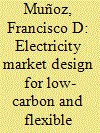

|
|
|
|
|
| Summary/Abstract |
Chile was the first country that privatized all generation, transmission, and distribution services, and introduced competition in the generation segment. Nearly four decades after its creation, many features of the original electricity market design remain unchanged. In this paper, we provide a brief history of the Chilean electricity market and explain its main limitations going forward. Some of these include the use of a cost-based mechanism for spot transactions based on a merit-order curve, low temporal granularity of spot prices, missing forward markets to settle deviations from day-ahead commitments, inefficient pricing of greenhouse gas emissions due to administrative rules, and a capacity mechanism that does not reflect a clear resource adequacy target. Many of these limitations are also present in other electricity markets in Latin America that, when privatized, mirrored many features of the electricity market design in Chile. Failing to address these limitations will provide distorted incentives for the efficient entry and operation of resources that could impart flexibility to the system, increasing the cost of decarbonizing the power sector.
|
|
|
|
|
|
|
|
|
|
|
|
|
|
|
|
| 11 |
ID:
176843
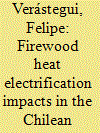

|
|
|
|
|
| Summary/Abstract |
Chile presents an extended use of low-quality firewood for residential heating. This raises serious concerns, mainly related to health problems due to particulate emissions from firewood combustion. Several initiatives have been considered by the Chilean government to address this, including heat electrification goals. In addition, the Chilean power system is undergoing a decarbonization process. This paper analyzes the impacts of firewood heat electrification over the Chilean power system’s decarbonization process until 2044, based on a capacity expansion planning model and an estimation of firewood heat demand, to account for major changes in load shape and spatial distribution. The results show that there is a large increase in the power system total cost (ranging from 5.6% to 19.4%), with flexibility requirements becoming larger in the south. Technologies that strongly depend on local resource availability, such as wind and concentrated solar power, present changes in their systemic value, altering the need for storage and flexibility. Also, aspects such as household insulation, electrification efficiency, and smart heating technologies would significantly impact the process in terms of cost reduction and optimal generation mix. The policy implications for the Chilean power system are presented, within the broader discussion of the overall firewood problem.
|
|
|
|
|
|
|
|
|
|
|
|
|
|
|
|
| 12 |
ID:
180123


|
|
|
|
|
| Summary/Abstract |
Environmental, energy, transport and agriculture policies are intersecting when deciding on renewable energy in transport (RES-T) implementation strategies. The uncertainty related to the advanced biofuels, limitations and underperformance of readily available technologies for decarbonization of transport sector challenges RES-T policy making. This paper employs partitioning as a choice architecture tool to create a concerted RES-T policy. The approach collects the preferred attributes of an alternative fuel rather than the preferred fuel by guiding stakeholders through RES-T policy, ensuring that all aspects of concerted policy are covered. Fuzzy analytical hierarchical process (fAHP) has been superimposed on the partitioning related to the biofuels to mathematically weight the alternatives. fAHP ranks the weighted preferences on biofuels to build a consensus among stakeholder groups, later translated to the actual RES-T mix, quantities and investments needed to meet the mandated share. Applied on Croatia, the preferences of three stakeholder groups were weighted and ranked; whereas some discrepancies were identified, the consensus outlined the national transport decarbonization policy with related investments. When the consensual RES-T mix contrasted with the least-cost alternative, the investment needed was reduced to a quarter. The collaborative management process proved to be a time-effective participatory approach for a silo-based policy structure.
|
|
|
|
|
|
|
|
|
|
|
|
|
|
|
|
| 13 |
ID:
185685


|
|
|
|
|
| Summary/Abstract |
Supporting the adoption of zero-emission vehicle (ZEVs), including plug-in electric vehicles (EVs), has become a priority for governments due to their ability to reduce petroleum demand, improve air quality, and reduce carbon dioxide (CO2) emissions. Optimal strategies to accelerate EV adoption must weigh the relative value of alternative policy mechanisms to consumers, including public charging infrastructure and vehicle purchase subsidies. We use a historically validated light-duty vehicle consumer choice tool, the ADOPT model, to simulate personal light-duty vehicle adoption and related emissions in California. ADOPT is updated to incorporate a quantification of the tangible value of public charging infrastructure, allowing us to simulate the impact of investments in public charging infrastructure and vehicle purchase subsidies under different scenarios. We show that both policies result in increased EV adoption, with the most effective policy varying depending on vehicle technology assumptions. Under conservative technology improvement assumptions, infrastructure investments are most effective in promoting EV sales and reducing CO2 emissions, while under optimistic technology improvement assumptions a combination of infrastructure and subsidies best supports EV sales and CO2 emission reductions.
|
|
|
|
|
|
|
|
|
|
|
|
|
|
|
|
| 14 |
ID:
191283
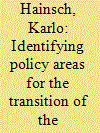

|
|
|
|
|
| Summary/Abstract |
Being the only energy sector where emissions are still at 1990 levels, the German transportation sector requires rapid decarbonization to achieve ambitious climate targets. Policy makers need to put the framework in place which enables and supports this transition. This work analyzes which policy areas should be targeted considering interactions with and implications for the entire energy system. The Global Energy System Model (GENeSYS-MOD) is used to compute 400 sensitivities which showcase the effectiveness of specific transport and energy system related policies. Shifting transportation demand to less energy and emission intensive modes or avoiding it in the first place shows the strongest effect on a number of key metrics. Primary energy consumption, emissions, and fleet size can all be reduced through a combination of electrification and shift towards public transport and long-distance trains. Carbon prices also showcase significant effects while further affecting the other energy sectors. The results suggest that in the intermediate term, modal shift and demand reduction can help with reducing transportation related emissions, while carbon prices are effective after 2040.
|
|
|
|
|
|
|
|
|
|
|
|
|
|
|
|
| 15 |
ID:
192707
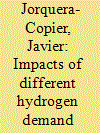

|
|
|
|
|
| Summary/Abstract |
As countries continue to update their climate ambitions, they are seeking cost-effective solutions for decarbonizing energy use. In this context, low-carbon hydrogen production and use presents relevant opportunities for emissions reductions and economic development, and recent studies show important potential benefits from integrating electricity and hydrogen networks. Based on a novel mathematical optimization model, we conduct a case study for Chile in 2020–2050 to assess the least-cost evolution of the integrated hydrogen–electricity system, testing different carbon prices, 100% renewable mandates, and incorporating domestic and international hydrogen demand. By optimizing over various scenarios, we find that, due to the country’s significant renewable potential and the flexibility that electrolyzers can provide, adding hydrogen exports to domestic hydrogen use may enhance renewable integration, while not necessarily increasing average wholesale electricity prices for typical end-users (relative to our baseline scenario), but also make battery deployment unattractive. Further, we conclude that climate policies such as a high carbon price or a 100% renewable mandate may be crucial to achieve a fully renewable system by 2050 and reduce cumulative emissions, resulting in 3%–14% higher net present system costs. Finally, we discuss that various concerns such as water and land use must be addressed by policymakers.
|
|
|
|
|
|
|
|
|
|
|
|
|
|
|
|
| 16 |
ID:
127297


|
|
|
|
|
| Publication |
2014.
|
| Summary/Abstract |
This article employs the multi-level perspective on socio-technical transitions to explore the historical evolution of the electricity regime in the province of Ontario from 1885-2013 and to interpret the potential for future movement towards decarbonization. With an emphasis on the political and social dimensions of transitions, this analysis traces the key features influencing change within Ontario's electricity system over the past century. This paper uses multiple criteria (the phase of electrification; role of the electricity system in economic development; structures of ownership, market and regulation; dominant technologies; and the relative stability of arrangements) to characterize distinct regime configurations and periods of instability which separate relatively stable system orientations. Lessons are drawn from the historical case with implications for future decarbonization in the province, including the importance of: (1) residual momentum; (2) embedded guiding principles; and, (3) Politico-Economic Coalitions.
|
|
|
|
|
|
|
|
|
|
|
|
|
|
|
|
| 17 |
ID:
166518
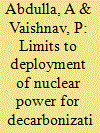

|
|
|
|
|
| Summary/Abstract |
Decarbonization will require deployment of low-carbon technologies, but analysts have struggled to quantify which ones could be deployed in practice—especially where technologies have faced public opposition. For nuclear power, some analysts have tried to solve this problem with caps on deployment or nuclear-free scenarios; however, social science research has not offered nuanced guidance about these caps. We deploy an experiment involving a large U.S. sample (N = 1226) to disentangle public opposition due to the dread of nuclear power from opposition stemming from its actuarial risk. Respondents are asked to build a power generation portfolio that cuts CO2 emissions, given information about the actuarial risks of technologies. Half the sample is exposed to the nuclear power label while the other half is treated with the risk information but blinded to the label. Respondents who see the labels deploy 6.6 percentage points less nuclear power as a share of the U.S. electricity mix. Our results suggest that dread about nuclear power leads respondents to choose 40% less nuclear generation in 2050 than they would have chosen in the absence of this dread. These methods could apply to other technologies, such as carbon storage, where there may be gaps between actuarial and perceived risks.
|
|
|
|
|
|
|
|
|
|
|
|
|
|
|
|
| 18 |
ID:
155670
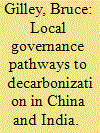

|
|
|
|
|
| Summary/Abstract |
Reducing greenhouse gas emissions in the world's two largest countries requires feasible governance pathways that integrate politics, policy and administration. Using examples of successful mitigation at the local level in China (Guangzhou) and India (Gujarat), this article identifies integrated governance solutions that work in both cases through different types of linkages. In China, it is mainly intra-governmental linkages, while in India it is mainly state–society linkages. In neither case do international negotiations concerning emissions targets have significant effects, while national frameworks have only marginal effects. Approaching the problem in this comparative manner helps to clarify how greenhouse gas governance operates in each country, the lessons for central–local environmental relations, and the implications for international assistance.
|
|
|
|
|
|
|
|
|
|
|
|
|
|
|
|
| 19 |
ID:
177312
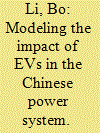

|
|
|
|
|
| Summary/Abstract |
The deployment of renewable electricity and electric vehicles (EVs) provides a synergistic opportunity to accelerate the decarbonization of both China's power and transportation sectors. Here, we evaluate the potential impacts of EVs by utilizing the SWITCH-China model designed to meet emissions constraints within its power sector while integrating the electrified transportation sector. We focus on how various EV stocks, and charging strategies (unmanaged versus smart charging) impact the power sector, in terms of generation and hourly grid operation, the capacity mix, and achieving the Paris Agreement goals. Large-scale deployment of EVs increases the need for generation capacity, while the implementation of smart charging requires 6.8%–14% less additional storage capacity. We calculate that power system integration costs to incorporate EVs range from $228 - $352 per EV. We show that a smart charging strategy saves between $43 and $123 per vehicle more annually in 2050 than a case with the same EV stock where the charging is unmanaged. Our results suggest that a 140 GW annual growth of renewables from 2020 to 2050, coupled with an aggressive EVs deployment using smart charging can put China solidly on a path to meet its ambitious carbon cap targets.
|
|
|
|
|
|
|
|
|
|
|
|
|
|
|
|
| 20 |
ID:
186417


|
|
|
|
|
| Summary/Abstract |
Between 2013 and 2020 the EU set up a complex institutional system to select and support the implementation of energy infrastructure projects that are of European interest (PCIs). EUR 1.4 billion EU support was awarded to 16 natural gas projects between 2014 and 2019, most of them are still under construction. With the decarbonization agenda emerging, fossil investments have a limited lifetime to recover their investment. To assess the net socio-economic benefits of the gas PCI projects a modelling-based cost benefit analysis was applied. Results revealed that the cross-border projects that were implemented so far have a joint socio-economic benefit/cost ratio (B/C) above 1 even in the most conservative scenario setups. The ones with a final investment decision would need to face a high gas price environment in the future to push the B/C above 1, which is the reality since 2021. The other projects on the full EU list of PCIs are not beneficial as a single group, as they serve similar needs. Some individual non-FID projects are though promising.
|
|
|
|
|
|
|
|
|
|
|
|
|
|
|
|
|
|
|
|
|